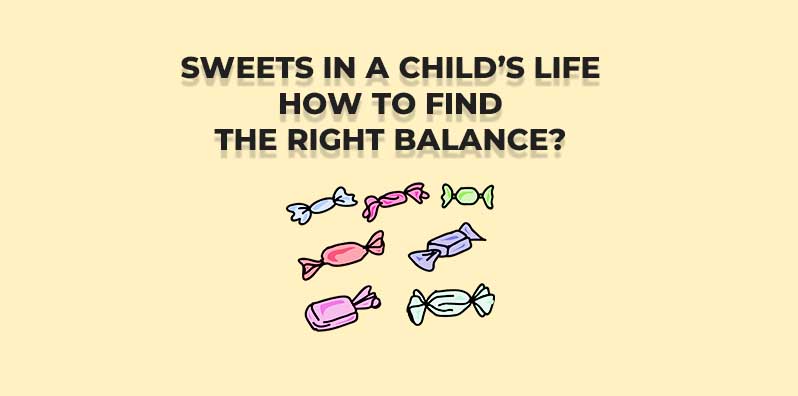
Sweets are an inseparable part of childhood. Chocolates, lollipops, cookies – they tempt with their taste and appearance and are often used as rewards. However, excessive consumption can lead to health problems such as obesity, tooth decay, or metabolic disorders. So how should parents approach sweets in their child’s diet to find a healthy balance? Here are some principles worth implementing.

What Should Parents Avoid?
- Completely banning sweets – A total ban on sweets may lead to a child sneaking them or binge-eating whenever the opportunity arises. This can also create an unhealthy relationship with food.
- Using sweets as a reward – Associating sweets with achievements or good behavior can encourage emotional eating in the future.
- Stocking up on unhealthy products – If the pantry is full of sugary snacks, children will naturally reach for them more often.
- Limiting sweets for the child but consuming them yourself – Children learn by imitation. If parents regularly eat candy or sugary drinks, children will want to follow suit.
What Should Parents Do?
- Encourage moderation – Allow sweets, but in controlled amounts and on specific occasions. For example, you can designate one day a week for sweet treats.
- Promote healthier alternatives – Fruits, homemade baked goods with minimal sugar, dried fruits, or natural yogurts can be great substitutes for store-bought sweets.
- Teach mindful eating – Explain why excessive sugar intake is harmful and discuss the benefits of a balanced diet.
- Set a good example – If children see their parents enjoying sweets in moderation, they will learn to do the same.
- Encourage physical activity – Occasional sweets are less harmful when balanced with an active lifestyle.
Building a Healthy Relationship with Sweets
A healthy approach to sweets means not attaching excessive emotional value to them. Sweets should not be strictly forbidden, nor should they be a special reward. When they are treated as part of a normal diet in appropriate proportions, children learn moderation and make better choices.
Demonizing sweets, hiding them, or enforcing strict bans may make them even more desirable. As a result, children may overeat whenever they have access. A better strategy is education and fostering healthy habits.

How to Shape a Child’s Healthy Relationship with Sweets?
- Do not hide sweets or treat them as something extraordinary. Let them be a part of the diet but not a special, exciting treat.
- Do not establish a habit of having dessert after every meal. Sweets should be occasional treats, not a daily routine.
- Avoid excessive restrictions but teach wise choices. Instead of banning sweets entirely, show children how to choose healthier alternatives, such as homemade treats over processed candies.
- Do not use sweets as a reward or source of comfort. If a child associates sweets with improving their mood, they may turn to sugar for emotional relief later in life.
- Encourage trying different flavors and natural sources of sweetness. Fruits, dried nuts, or yogurts can provide pleasure without excessive sugar intake.
- Ensure that family and friends follow similar habits. Ask those around you not to bring sweets as gifts and instead opt for non-food presents.
Conclusion
Sweets can be part of a child’s diet, but the key is a balanced approach. Avoiding extremes—whether strict bans or unlimited access—is essential. By teaching children healthy habits, demonstrating wise choices, and leading by example, we help them develop a lifelong positive relationship with food.

